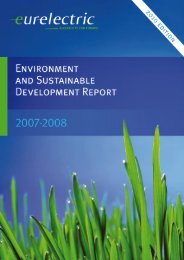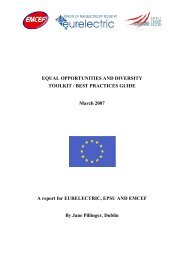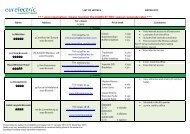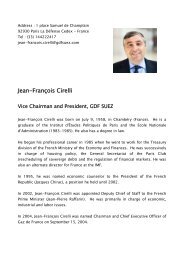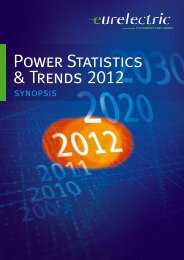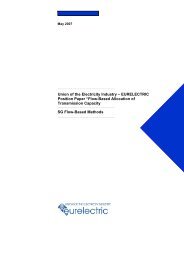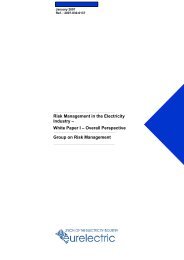Power Statistics - 2010 Edition - Full Report - Eurelectric
Power Statistics - 2010 Edition - Full Report - Eurelectric
Power Statistics - 2010 Edition - Full Report - Eurelectric
You also want an ePaper? Increase the reach of your titles
YUMPU automatically turns print PDFs into web optimized ePapers that Google loves.
Demand<br />
2.3 Comments<br />
AUSTRIA (at)<br />
In the last decade electricity demand in Austria increased by approximately 2% per year. The estimated<br />
growth rate up to 2020 is below this due to the financial crisis and energy efficiency measures.<br />
Until today the development of Austria’s electricity consumption is still highly correlated with the<br />
development of GDP. For the future development efforts for a decoupling of these parameters are<br />
undertaken especially through the improvement of energy efficiency measures.<br />
GERMANy (de)<br />
In 2009 electricity net consumption was -4.9% lower than in 2008. In conjunction with GDP growth<br />
a further decoupling of electricity consumption and economic growth can be started in the long run,<br />
although in the light of the economic crisis, the close correlation of economic performance and electricity<br />
consumption became obvious in the short term. Nevertheless, higher energy efficiency, a better<br />
understanding for energy saving measures and a growing service sector mainly determine the trend of<br />
further decoupling.<br />
SPAIN (es)<br />
Table 2.1.: The interconnected total and peak demand corresponds to the mainland system, excluding<br />
the autoproducers’ self-consumption. Total energy demand corresponds to the overall Spain. Peak<br />
demand does not include the one corresponding to the autoproducers’ self-consumption.<br />
FINLAND (fi)<br />
Electricity consumption decreased from 90.4 TWh in 2007 to 87.2 in 2008 mainly due to the economic<br />
crisis in autumn 2008.<br />
The prognosis of future electricity consumption was made by Finnish Energy Industries in 2009 in<br />
cooperation with Confederation of Finnish Industries EK. The prognosis is based on an average annual<br />
economic growth of 2 percent and the population is assumed to grow from the current 5.35 million to<br />
5.9 million by 2030. The prognosis of the industrial sector’s electricity consumption is based on the<br />
inquiry which was sent to the major industrial electricity consumers.<br />
Peak-load usually occurs in Finland on cold winter days. The sensitivity of peak demand to outdoor<br />
temperature is approximately 140 MW/ºC. The highest demand of all time was reached in February 2007<br />
when the consumption during one hour exceeded 14,800 MW. Winters after that have been mild apart<br />
from winter 2009-<strong>2010</strong>, when consumption during one hour was 14,460 MW in January. Peak load is<br />
expected to increase in the future in proportion to electricity demand.<br />
The prognosis of energy consumption outside the electricity sector is from the Finnish Energy and<br />
Climate Strategy that was published in 2008. The target for maximum energy consumption is used.<br />
LITHUANIA (lt)<br />
Final electricity consumption in 2009 was 9.16 TWh representing a decrease about 7.3% on the<br />
previous year. In 2009, the major consuming sector was commerce and others (3.53 TWh). About<br />
3.61 TWh were exported during the year 2009. Losses in the network have decreased about 4.9% i.e.<br />
from 1.02 TWh in 2008 to 0.97 TWh in 2009.<br />
<strong>Power</strong> <strong>Statistics</strong> – <strong>2010</strong> <strong>Edition</strong> – <strong>Full</strong> <strong>Report</strong> 65



